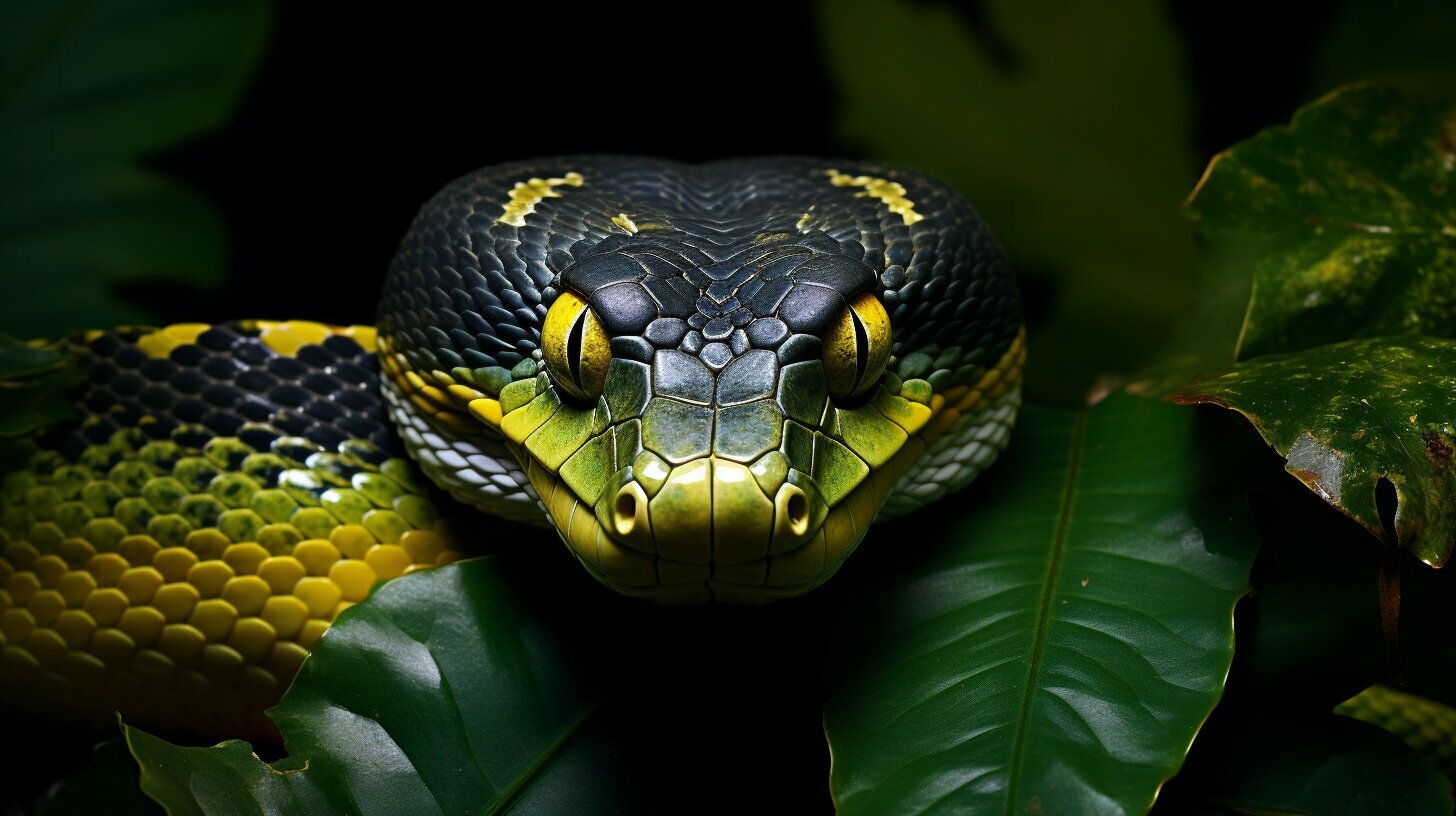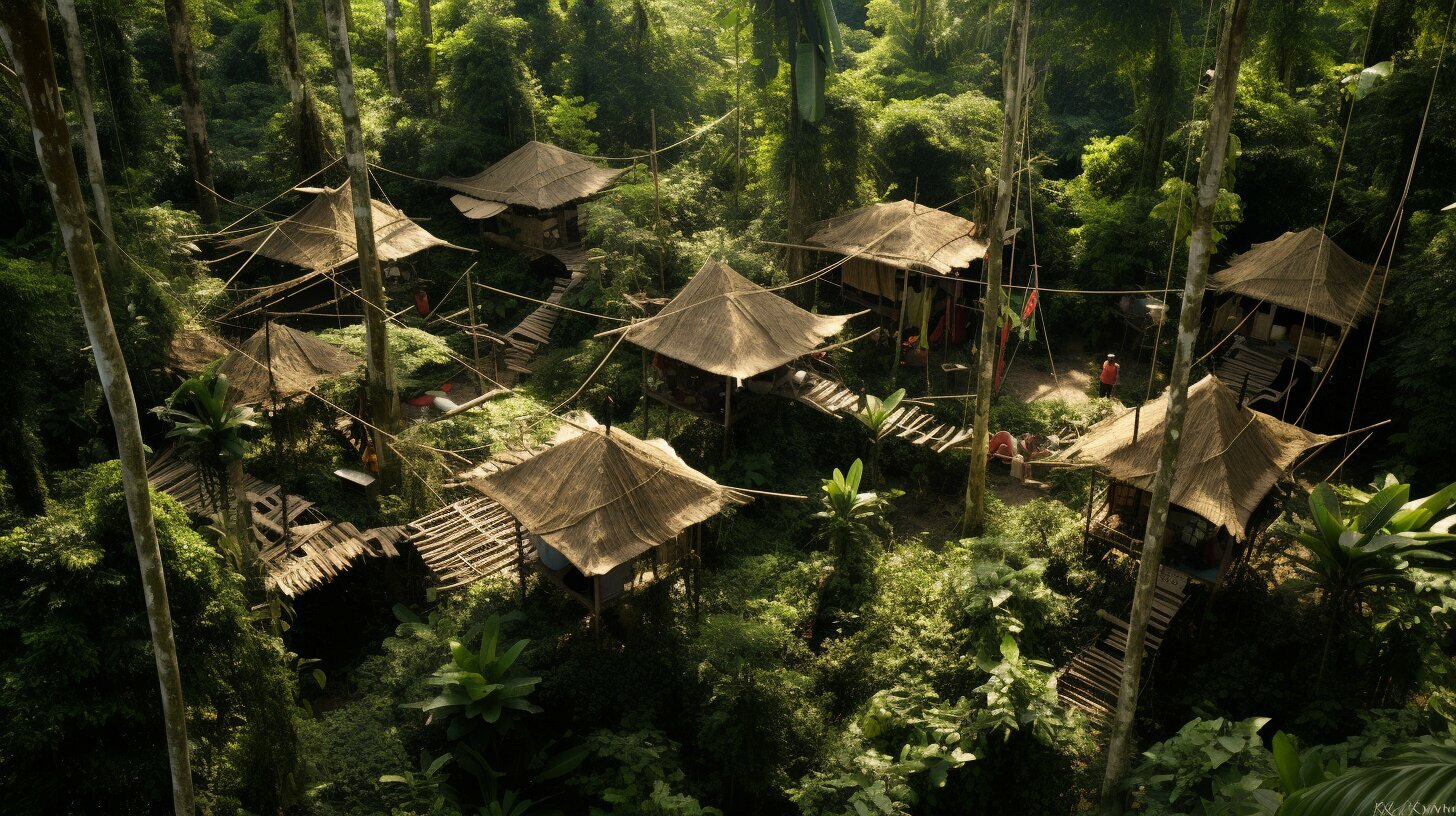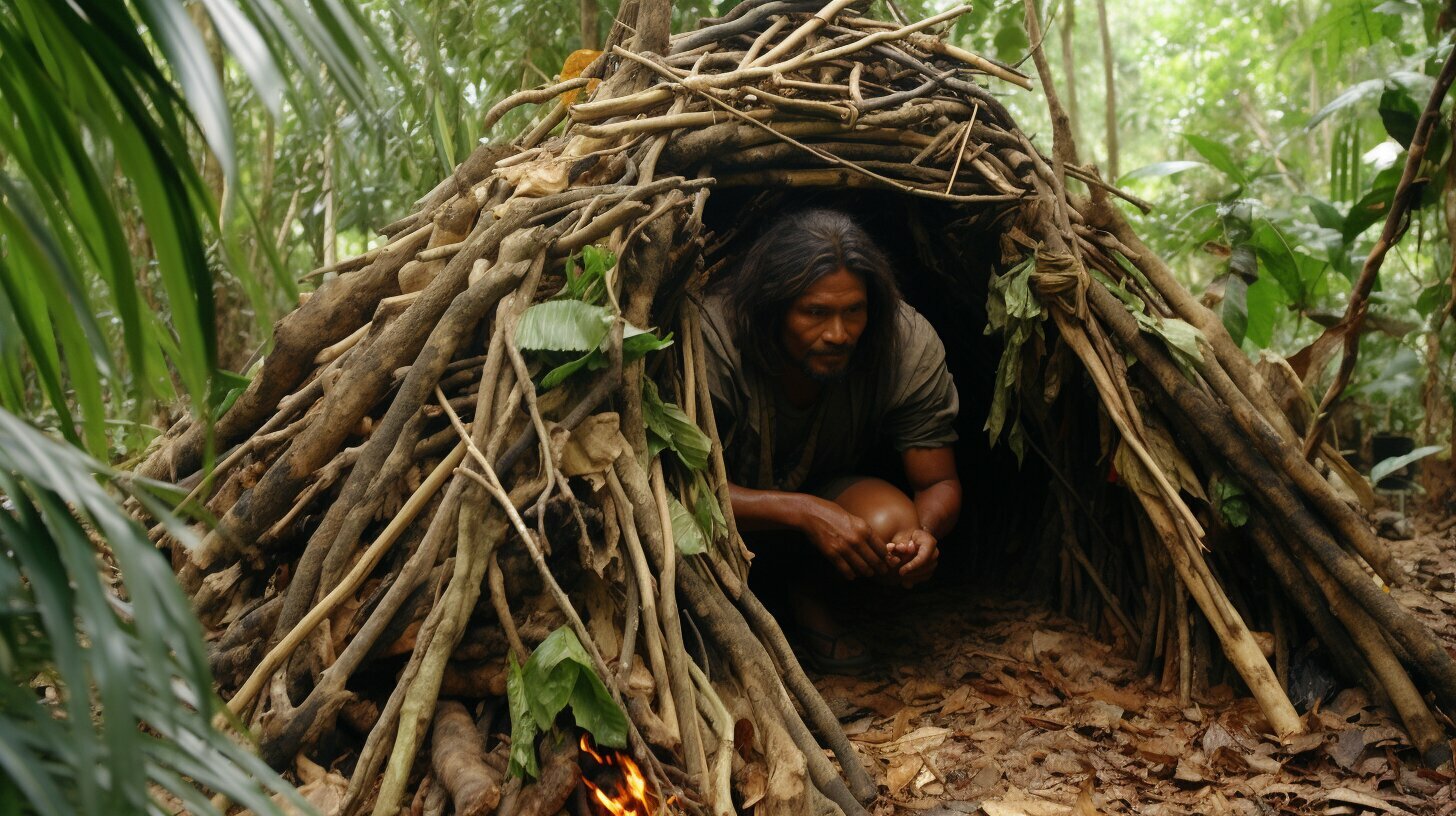When venturing into the jungle, it’s essential to be mindful of your surroundings and take appropriate precautions to avoid snakes and other jungle predators. These creatures can pose a significant threat to your safety, but by following jungle animal safety precautions and employing effective jungle survival strategies, you can reduce the risk of encountering them.
In this comprehensive survival guide, we will provide you with essential tips and techniques to help you navigate through the wilderness safely, specifically focusing on avoiding snakes and jungle predators. By learning how to identify venomous snakes, implementing snake-safe camping practices, and understanding emergency response to snake bites, you can ensure your safety in snake-inhabited areas.
Disclosure: When you buy through links on our site, we may earn an affiliate commission.
Key Takeaways
- Learn how to recognize venomous snakes before venturing into the jungle.
- Implement snake-safe camping practices to reduce the risk of snake bites.
- Understand emergency response to snake bites and seek medical assistance immediately.
- Employ effective jungle survival strategies to ensure your overall safety in the jungle.
- Stay vigilant in snake-inhabited areas and take appropriate precautions to avoid jungle predators.
Understanding Jungle Predators
When exploring snake-inhabited areas, it is essential to understand jungle predator avoidance techniques and stay vigilant at all times. The jungle is home to a variety of predators, including snakes, big cats, and crocodiles. However, with the right knowledge and preparation, you can minimize the risk of encounters.
Jungle predator avoidance techniques
- Make noise: Animals are less likely to approach if they hear you coming. Clap your hands, sing, or talk loudly to alert predators of your presence.
- Stay on designated trails: Avoid bushwhacking or wandering off designated trails, as this can lead you into the territory of predatory animals.
- Always be alert: Keep your senses sharp and be aware of your surroundings. Keep an eye out for movement and listen for any unusual sounds that could indicate the presence of a predator.
- Carry a stick: A stick can be used for self-defense against predators. Use it to create distance between yourself and predators or to ward off an attack.
Staying vigilant in snake-inhabited areas is crucial for your safety. Snakes are often difficult to see, and if you’re not paying attention, you could easily step on one. Consider wearing snake-resistant boots to reduce the risk of bites.
Snake-resistant boots
| Brand | Features |
|---|---|
| LaCrosse Men’s Adder 18” Snake Boot | Waterproof, scent-free, and snake-resistant, with a locking zipper for a secure fit. |
| Danner Men’s Sharptail Snake Boot | Durable leather with snake-resistant protection and a waterproof liner to keep feet dry. |
| Rocky Men’s ProLight Waterproof Snake Boot | Designed with waterproof and snake-resistant material, with an EVA midsole for added comfort. |
Now that you know some jungle predator avoidance techniques and how to stay vigilant in snake-inhabited areas, you can enjoy your outdoor adventures with confidence.
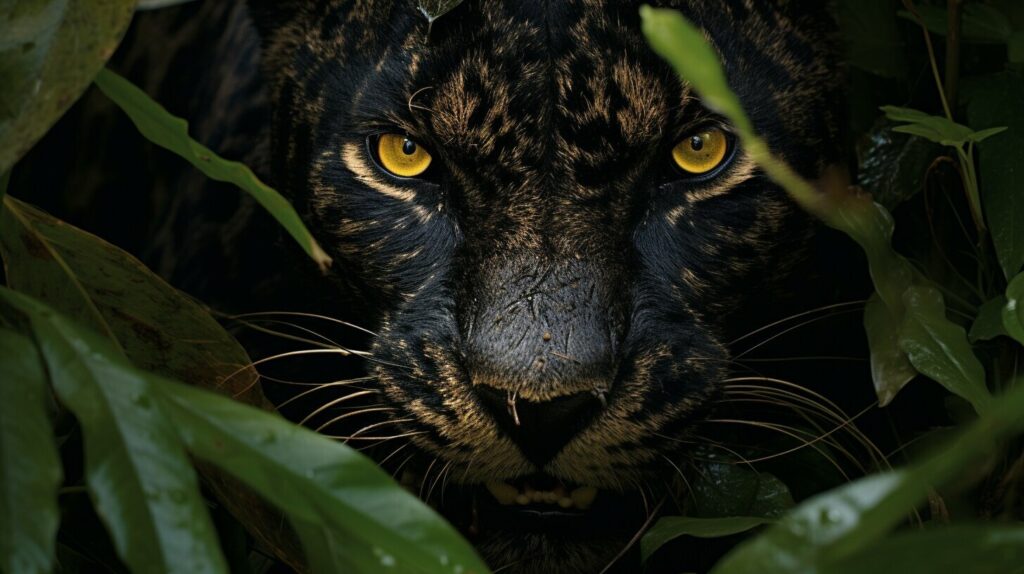
Identifying Venomous Snakes
Preventing snake bites in the wilderness should be a top priority for any adventurer venturing into snake-inhabited areas. The key to avoiding snake bites is being able to identify venomous species. Here are some helpful tips to keep you safe:
Learn to Recognize Different Snake Species
While there are over 3,000 species of snakes worldwide, only around 600 are venomous. Learning to recognize the characteristics of different snake species will help you to identify venomous snakes in the wild. For example, pit vipers have a triangular-shaped head, vertical pupils, and a heat-sensing pit between the nostril and eye.
Understand Snake Habitats
Knowing where snakes like to live is another crucial factor in avoiding snake bites. Venomous snakes tend to prefer warm, humid environments, such as swamps, marshes, and forested areas. Be especially careful when walking near rocks, logs, and overgrown vegetation, as these are popular hiding spots for snakes.
Stay Vigilant in Snake-Inhabited Areas
Staying vigilant and alert is important when traveling through snake-inhabited areas. Watch where you step, use a walking stick to probe ahead, and wear boots and long pants to protect your legs. Always be aware of your surroundings and listen for warning signs like rustling leaves or the sound of a rattle – both of which could indicate the presence of snakes.
| Non-Venomous Snakes | Venomous Snakes |
|---|---|
| Corn Snake | Copperhead |
| Garter Snake | Rattlesnake |
| Bullsnake | Cottonmouth |
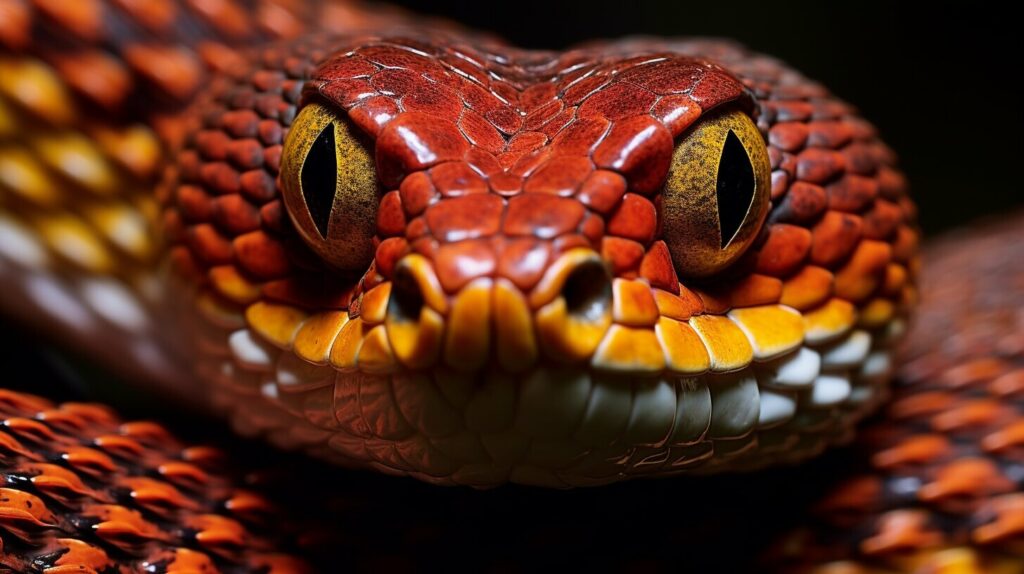
“Keep in mind that not all venomous snakes are born killers. Most are shy creatures that only bite humans in self-defense. Respect them, and they will respect you.”
By learning how to identify venomous snakes, recognizing their habitats, and staying vigilant in snake-inhabited areas, you can significantly reduce the chances of snake bites in the wilderness. However, accidents can still happen, and it’s important to be prepared for the worst. In Section 8, we’ll cover what to do in case of a snake bite emergency.
Jungle Animal Safety Precautions
When venturing into the wilderness, it is essential to take precautions to ensure your safety. By following these tips for staying safe in the wild, you can avoid dangerous encounters with jungle predators and prevent snake bites in the wilderness.
- Dress appropriately: Wear long pants and boots to protect your legs from snake bites. Avoid brightly colored clothing that may attract animals.
- Use insect repellents: Apply insect repellent to prevent insect bites and stings. Mosquitoes and other biting insects can transmit diseases and attract predators.
- Store food properly: Keep your food in sealed containers and away from your sleeping area to avoid attracting animals. Hang food at least 10 feet off the ground and 4 feet away from any tree trunk, or use a bear canister.
- Stay on marked trails: Keep to designated trails to avoid stepping on or disturbing animals. This will also help you navigate more easily and avoid getting lost.
- Carry a first-aid kit: Pack a kit with a snake bite kit, antihistamines, and other essentials to treat insect bites, cuts, and other injuries.
By following these jungle animal safety precautions, you can minimize your risk of encountering dangerous predators and stay safe in the wild. In the next section, we will cover tips for implementing snake-safe camping practices.
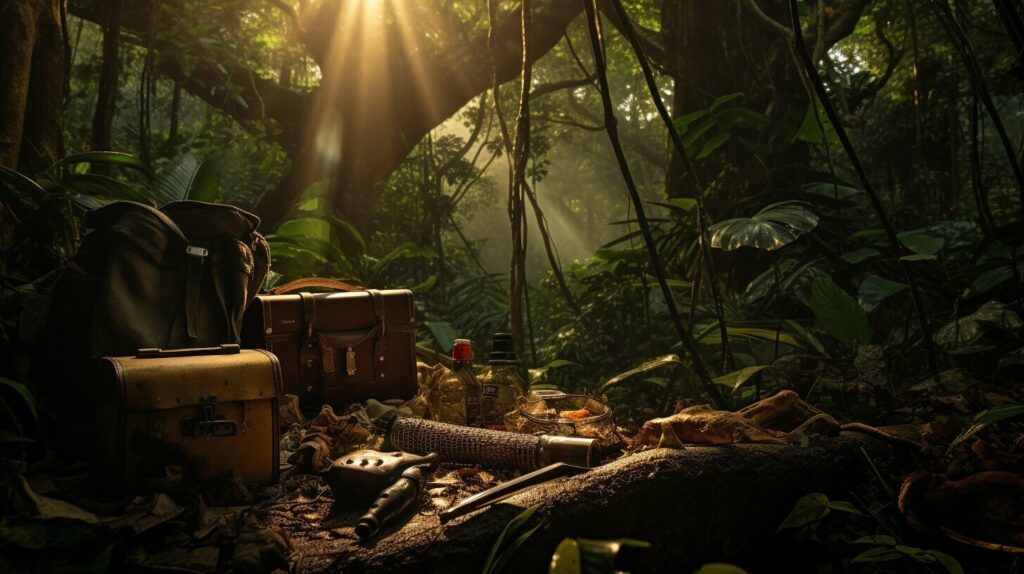
Snake-Safe Camping Practices
Planning a camping trip in snake-inhabited areas requires specific wilderness safety tips to prevent snake bites in the wilderness.

When choosing a campsite, look for areas that are clear of tall grass and debris where snakes could hide. Set up your tent on a flat, raised surface, and ensure that it is securely fastened to the ground.
Store food in airtight containers and keep them at least 100 yards away from your campsite, preferably in a sealed vehicle. This will prevent snakes and other animals from being attracted to your sleeping area.
When hiking, stick to designated paths and avoid tall grass and underbrush where snakes could be hiding. Always keep a safe distance from any wildlife you encounter and never attempt to touch or feed them.
Snake-Safe Camping Checklist
- Choose a campsite clear of tall grass and debris
- Set up tent on a flat, raised surface
- Securely fasten tent to the ground
- Store food in airtight containers at least 100 yards away from your campsite in a sealed vehicle
- Stick to designated paths
- Avoid tall grass and underbrush
- Keep a safe distance from wildlife
- Never attempt to touch or feed animals
Jungle Survival Strategies
Surviving in the jungle requires knowledge and skills to navigate and overcome the challenges that come with it. Whether you’re an experienced hiker or a first-time adventurer, implementing effective jungle survival strategies can make all the difference in your safety and well-being.
Navigation Techniques
Navigating through the dense jungle can be difficult and disorienting. Therefore, learning various navigation techniques can help you stay on track and prevent you from getting lost. One of the most effective ways to navigate is by using a compass, as it can help you maintain a sense of direction even in the absence of landmarks. You can also use natural markers, such as tree trunks or large rocks, to help you navigate.
Building a Shelter
Building a shelter is crucial for protecting yourself from the elements and ensuring your survival in the jungle. When constructing a shelter, look for a location that is dry and protected from wind and rain. You can use various materials such as leaves, branches, and vines to build your shelter. A sturdy and waterproof shelter can make all the difference in keeping you safe and comfortable in the jungle.
Finding Sources of Water
In the jungle, access to clean water is vital for survival. However, finding reliable sources of water can be challenging. Some common sources of water in the jungle include rivers, streams, and waterfalls. You can also collect rainwater by using a tarp or other waterproof material to funnel water into a container. It’s essential to boil or treat water before drinking to avoid contracting water-borne illnesses.
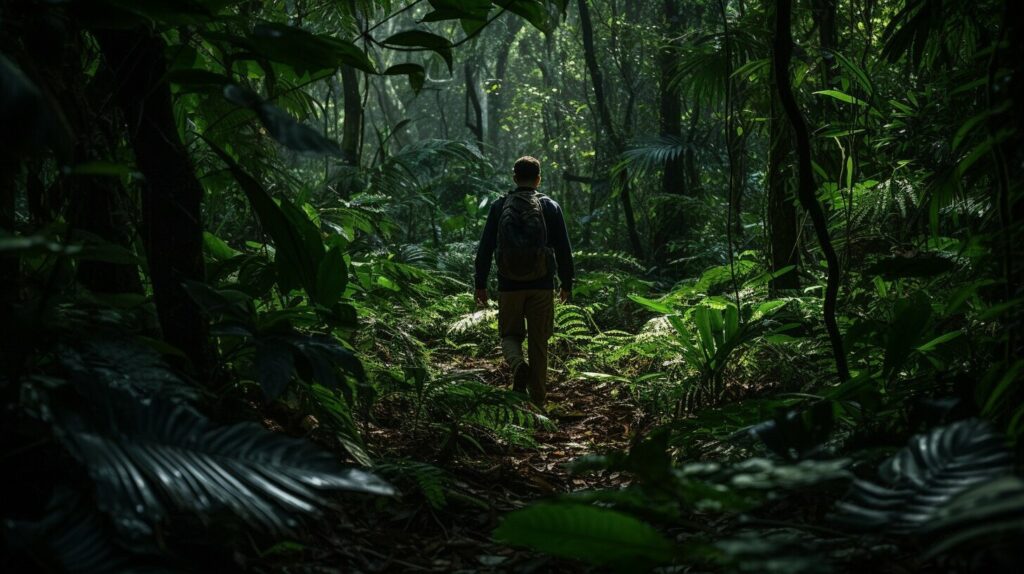
Staying Vigilant
Being aware of your surroundings and staying vigilant in snake-inhabited areas can significantly reduce the risk of encountering predators. This includes avoiding tall grass and bushes, wearing protective clothing, and using snake repellent methods. Additionally, it’s crucial to always carry a first aid kit and emergency supplies, such as a whistle and a signaling device, in case of an emergency.
Employing effective jungle survival strategies can make all the difference in your safety and well-being when navigating through the wilderness. From navigation techniques to building a shelter and finding sources of water, being prepared and staying vigilant are essential for your survival in the jungle.
Snake Repellent Methods
While it’s impossible to completely eliminate the risk of encountering snakes in the wild, there are snake repellent methods that can help minimize the chances of snake bites. By using these methods along with other jungle survival strategies, you can increase your chances of staying safe in the wilderness.
Using Snake Repellent Sprays
One effective way to repel snakes is by using snake repellent sprays. These sprays contain natural ingredients like cinnamon oil and clove oil that snakes find unpleasant. To use the spray, simply shake the bottle and spray it around your campsite or other areas you plan to visit. Be sure to reapply the spray every few hours for maximum effectiveness.
Wearing Snake Gaiters
Another way to prevent snake bites in the wilderness is by wearing snake gaiters. These are protective coverings that go over your boots or shoes, providing an extra layer of defense against snake bites. They are made of materials like canvas or nylon and are reinforced with plastic or metal. When wearing snake gaiters, be sure to tuck your pants into them for optimal protection.
Other Repellent Methods
Other snake repellent methods include using mothballs, ammonia, or even a snake trap. However, these methods may not be as effective as snake repellent sprays or gaiters. It’s also important to remember that repellent methods are not foolproof and should be used in conjunction with other jungle survival strategies.
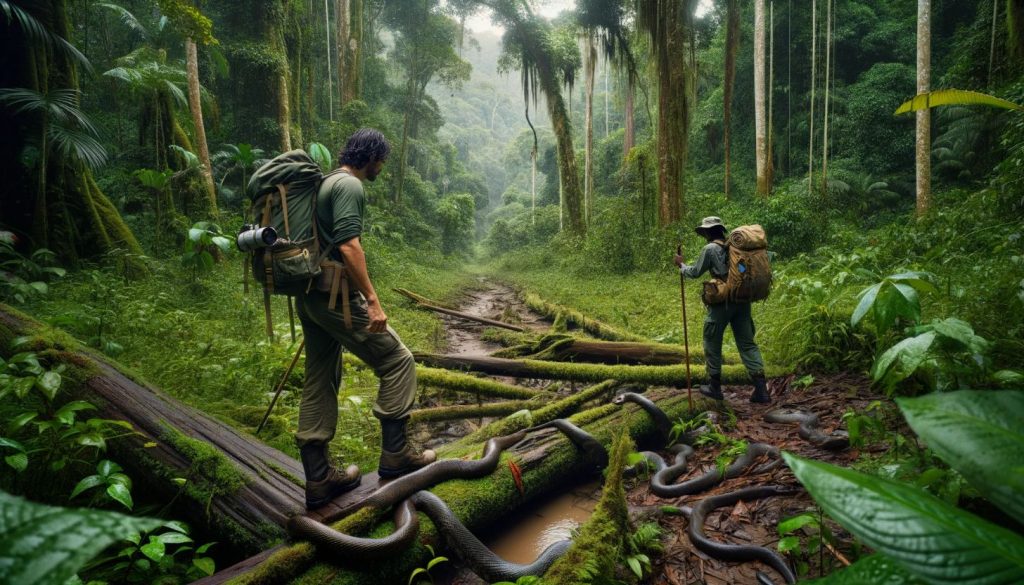
By using snake repellent methods and other jungle survival strategies, you can greatly reduce the chances of encountering snakes in the wild and prevent snake bites in the wilderness. Always stay vigilant in snake-inhabited areas and be prepared for any emergency situation. With the right knowledge and techniques, you can enjoy your outdoor adventures with confidence.
Emergency Response to Snake Bites
Despite taking all the necessary precautions, snake bites can still happen. If you or someone you are with is bitten by a snake, it is crucial to act quickly and seek medical assistance immediately.
The first step in the emergency response to snake bites is to immobilize the affected limb to prevent the venom from spreading. You can do this by using a splint or tie to keep the limb still and below heart level. It is important to keep the victim calm and still to avoid further spread of the venom.
Next, you should seek medical attention as soon as possible. Call 911 or your local emergency services to get help. Do not attempt to suck out the venom or apply a tourniquet, as these methods are ineffective and can make the situation worse.
If possible, try to identify the snake that bit the victim. Knowing the snake species can help identify the kind of anti-venom needed for treatment. However, do not waste time trying to catch the snake or take a photograph as this can put you at further risk.
Remember that prevention is always better than cure, and following the jungle survival strategies and preventing snake bites in the wilderness is the best way to avoid snake bites altogether.
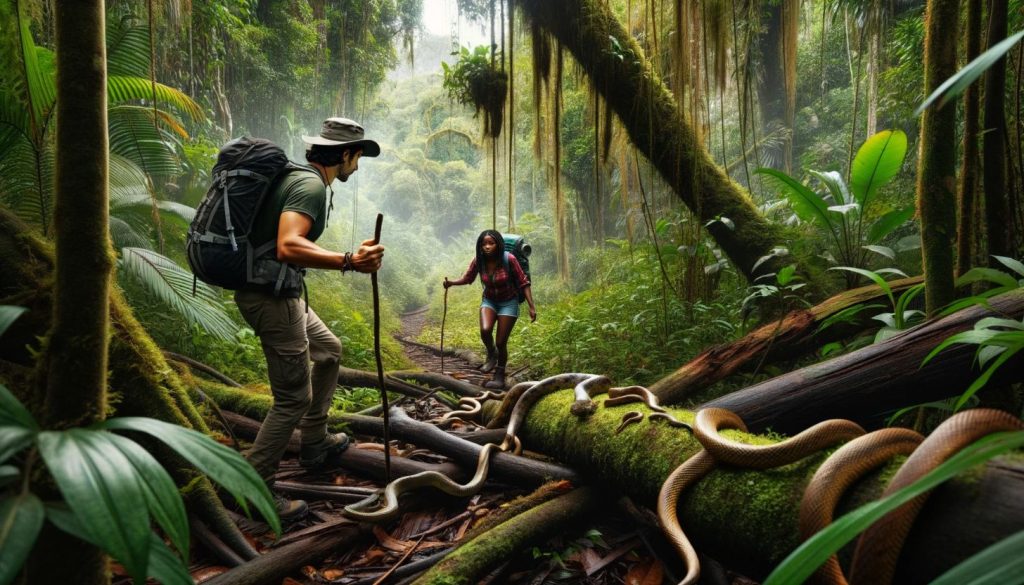
“It is crucial to act quickly and seek medical assistance immediately.”
Conclusion
Venturing into the jungle can be a thrilling adventure, but it comes with its share of potential risks, including encounters with snakes and other predators. This comprehensive survival guide has equipped you with essential knowledge and strategies to minimize these risks and ensure your safety in the wild.
By following jungle animal safety precautions and implementing effective jungle survival strategies, you can navigate through the wilderness with confidence. Recognizing venomous snakes, practicing snake-safe camping, and understanding emergency responses to snake bites are vital components of this safety plan.
Remember that staying vigilant in snake-inhabited areas and taking precautions are essential for a safe and enjoyable jungle experience. While encounters with wildlife can be unpredictable, your preparedness and awareness will significantly increase your chances of a successful and safe jungle adventure.
We hope this guide serves as a valuable resource for your jungle explorations and encourages responsible and respectful interactions with the natural world. Stay safe, stay informed, and embrace the wonders of the jungle with confidence and respect for its inhabitants.
FAQ
What are some jungle predator avoidance techniques?
To avoid jungle predators, it’s important to stay vigilant and attentive in snake-inhabited areas. Keep an eye out for movement, listen for rustling sounds, and be aware of your surroundings at all times.
How can I identify venomous snakes in the jungle?
Learning how to recognize different species of venomous snakes and understanding their habitats is key to preventing snake bites in the wilderness. Familiarize yourself with common characteristics and seek professional guidance if needed.
What are some jungle animal safety precautions?
To stay safe in the wild, it’s important to follow several precautions. Wear appropriate clothing to protect yourself, use insect repellents to deter pests, and practice proper food storage to avoid attracting predators.
Are there any wilderness safety tips for camping in snake-inhabited areas?
Yes, implementing snake-safe camping practices is crucial. Choose a suitable campsite away from snake habitats, securely set up your tent to prevent snakes from entering, and store food properly to avoid attracting them.
What are some effective jungle survival strategies?
To survive in the jungle, it’s important to be prepared. Learn navigation techniques, build a shelter using available resources, and find sources of water to ensure your overall survival in the unpredictable jungle environment.
Are there any snake repellent methods available?
While it’s not possible to eliminate the risk completely, there are snake repellent methods that can help. Use snake repellent sprays to create a barrier and consider wearing snake gaiters for added protection alongside your jungle survival strategies.
What should I do in case of a snake bite emergency?
If bitten by a snake, take immediate action. Immobilize the affected limb, seek medical assistance as soon as possible, and try to identify the species to determine potential venomosity. Time is of the essence in emergency response to snake bites.

